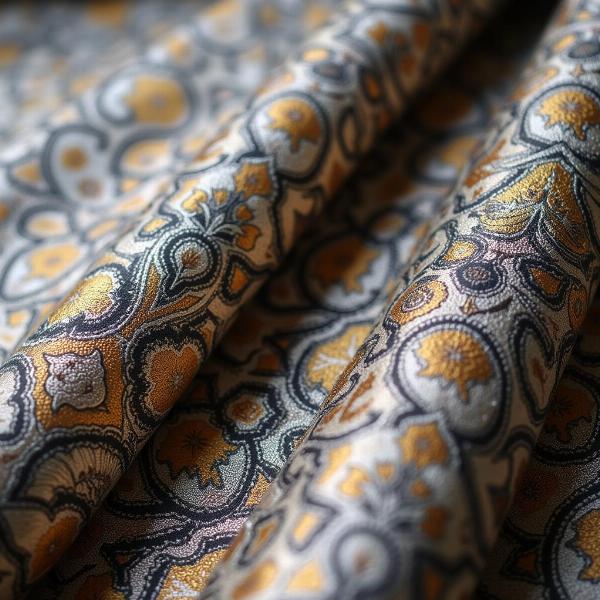Damask, known for its intricate patterns and luxurious feel, holds a significant place in textiles worldwide. But what does “damask” mean in Hindi? This article delves into the meaning, origins, characteristics, and cultural significance of damask, providing a comprehensive understanding of this revered fabric. We will explore its historical journey, its various types, and how its meaning has evolved over time in the Indian context.
Unraveling the Meaning of Damask in Hindi
Damask, often referred to as “दमिश्क” (Damishq) or “बुनाई” (Bunai) in Hindi, derives its name from Damascus, the ancient Syrian city renowned for its skilled artisans. While “Damishq” directly translates to Damascus, “Bunai” refers to the weaving technique used to create the distinctive patterns. The term emphasizes the intricate weaving process that sets damask apart from other fabrics. This rich history and complex craftsmanship contribute to the esteemed status of damask in Indian culture.
 Close-up view of damask fabric showing intricate woven patterns
Close-up view of damask fabric showing intricate woven patterns
The Art of Damask Weaving: A Legacy of Craftsmanship
Damask is not just a fabric; it’s a testament to the artistry of weaving. Characterized by reversible patterns woven into the fabric itself, damask differs from embroidery or printed designs. These patterns, often featuring floral motifs, geometric shapes, or elaborate scenes, are created by contrasting the weave structure of the warp and weft threads. This technique creates a subtle sheen and texture that adds to the allure of damask. The skill involved in creating these intricate patterns has been passed down through generations, making damask a symbol of heritage and tradition.
Types of Damask: From Silk to Linen and Beyond
Damask comes in various forms, each with its unique characteristics and applications. Silk damask, known for its luxurious sheen and drape, is often used for high-end garments and upholstery. Linen damask, with its crisp texture and durability, is popular for tablecloths and napkins. Cotton damask offers a more affordable option for everyday use, while wool damask provides warmth and comfort in colder climates. The versatility of damask allows it to be incorporated into various aspects of life, from clothing to home decor.
Damask in Indian Culture: A Symbol of Elegance and Tradition
In India, damask holds a special place in cultural traditions and celebrations. It’s often used for festive attire, particularly during weddings and religious ceremonies. The intricate patterns and luxurious feel of damask reflect the importance of these occasions, adding a touch of grandeur and elegance. From sarees and lehengas to turbans and decorative items, damask weaves its way into the fabric of Indian celebrations.
Caring for Your Damask: Preserving its Beauty
Maintaining the beauty of damask requires proper care. Generally, dry cleaning is recommended for most damask items, especially those made of delicate silk or wool. Linen and cotton damask can often be hand-washed or machine-washed on a gentle cycle, but always check the care label for specific instructions. Proper care ensures that your damask pieces remain vibrant and beautiful for generations to come.
Conclusion: The Enduring Allure of Damask
Damask, with its rich history, intricate patterns, and luxurious feel, continues to captivate people across cultures. Its meaning in Hindi, encompassing both the place of origin and the art of weaving, reflects the deep appreciation for this exquisite fabric. Whether adorning a bride on her wedding day or gracing a festive table, damask represents elegance, tradition, and timeless beauty.
FAQ
- What is the literal translation of “damask” in Hindi? The literal translation is “दमिश्क” (Damishq), referring to the city of Damascus.
- What is the significance of damask in Indian culture? Damask is often used for festive attire and celebrations, symbolizing elegance and tradition.
- How is damask made? Damask is created using a special weaving technique that produces reversible patterns in the fabric.
- What are the different types of damask? Common types include silk, linen, cotton, and wool damask.
- How do I care for damask? Dry cleaning is generally recommended, but some types can be hand-washed or machine-washed gently. Always check the care label.
- Is damask expensive? The price of damask varies depending on the material and complexity of the weave. Silk damask tends to be the most expensive.
- Where can I buy damask fabric? Damask fabric can be found in fabric stores, online retailers, and specialty shops.
Meaning-Hindi.in is your premier destination for high-quality Hindi translation services, catering to a wide range of needs from business and legal documents to technical manuals and website localization. Our expertise in various fields ensures accurate and culturally sensitive translations. Contact us today for all your Hindi translation needs at [email protected] or call us at +91 11-4502-7584. Meaning-Hindi.in is committed to delivering exceptional language solutions that bridge cultures and connect people.